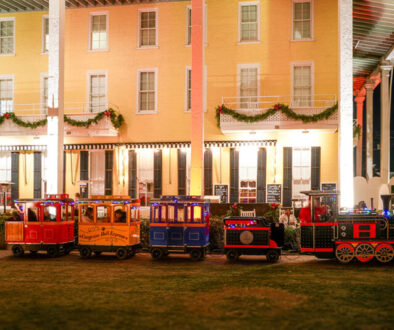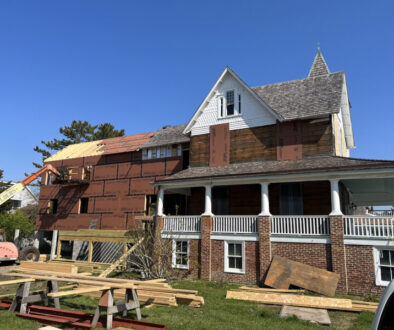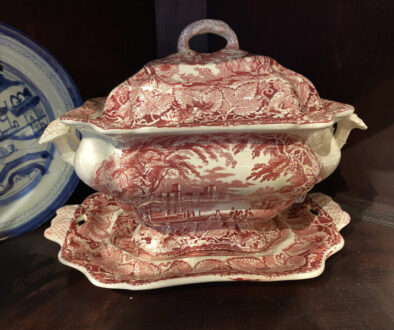Golden Slumbers
On the evening of December 8, 1980, Gene Schultz, now a Lower Township resident, but then of the prestigious Frank E. Campbell Funeral Home in New York City, was assisting a family with funeral arrangements for their deceased loved one at one of Campbell’s associate chapels. During their solemn preparations, Gene and the family became distracted by the sound of sirens as police cars and emergency vehicles sped by the funeral chapel located on Manhattan’s Upper West Side. Such sounds were a constant for New Yorkers during the 1980s when the city was experiencing the highest crime levels in its history. These sirens, however, were different. So steady and swift was the procession of emergency vehicles that the family asked Gene if they could all take a moment to see what was going on. Upon stepping outside and looking into a blaze of flashing red lights, they realized something very serious was happening just blocks away. Moments later, after police cars and an ambulance sped past them in the opposite direction, they went back inside to conclude their arrangements. Driving home later that night, Gene learned from news reports on his car radio that the commotion which piqued his and his grieving clients’ curiosity was the response to a well-planned shooting that would become one of the most shocking murders of the 20th century. Former Beatle John Lennon had been assassinated by a deranged gunman outside his apartment building as he and his wife, Yoko Ono, returned home from a recording session.

In the days that followed, photographers and reporters gathered at The Campbell Funeral Chapel on West 81st Street. “We had hordes of news media outside our front door thinking we would be taking care of Mr. Lennon’s body,” Gene recalls. “We had no idea if we were. We had not been contacted by anyone. After two full days, without any notifications or even a phone call, Yoko Ono came to our chapel very early in the morning.” Gene knew immediately from Yoko’s unannounced early arrival and her manner of dress that privacy would be paramount in Lennon’s funeral arrangements. “She was dressed in a simple jacket with a scarf around her head and had come to the chapel in a taxi cab,” Gene said of Yoko, who was not easily recognizable without her trademark black attire and dark glasses.
That week, on the day Gene and his associates had claimed Lennon’s body from the medical examiner, the heavily shrouded secrecy of Lennon’s funeral arrangements was divulged when the media was informed of Campbell’s involvement. A throng of news reporters, photographers, and fans were crowded outside the chapel as they returned with Lennon’s body. Yet, the massive mob was only a microcosm of the countless mourners, worldwide, who sought a moment of closure in saying goodbye to their favorite idol. “Perhaps it was someone at the medical examiner’s office,” Gene guesses. “Perhaps someone was paid off to leak the information. We’ll never know.”
Gene’s calm and clever focus to the compromised secrecy would ensure that Yoko would still have the privacy she requested in her husband’s final arrangements. Quick thinking had them hurriedly take Lennon’s body into the chapel through a side entrance just before the media had a chance to notice. Once inside, Lennon’s body was placed into a large container for immediate cremation. Gene’s next challenge was transporting Lennon’s body to the crematory in Ferncliff, New York without being noticed. “We then had a hearse pull up to the front entrance of the chapel,” Gene said, “a container was brought out and placed in the hearse, the director came out carrying the urn which would be used for the remains and got into the passenger side of the hearse and it pulled away. The news media and photographers followed in vans and cars. Once they were all gone, another hearse pulled up, and the actual container holding Mr. Lennon’s body was placed in it and proceeded to Ferncliff Crematory in Hartsdale, New York. About 10 minutes later, the decoy hearse returned with the empty box and the media realized they had been duped.”
Once Lennon was cremated, the task of getting the ashes to his widow was much easier. “Before leaving Ferncliff,” Gene said, “we phoned Yoko and arranged for her to meet us at the chapel at a certain time. She came, was presented with the ashes, got into a waiting taxi cab and went home.” As to the final resting place of Lennon’s ashes, Gene can only speculate. “There’s never been any indication as to where his ashes were placed,” Gene said. “But in Central Park is the Lennon memorial garden, Strawberry Fields. We have often felt that perhaps she spread the ashes there.”
The pursuits of Gene’s early life gave no indication toward a career in funeral directing, let alone being the last man who would prepare and lay to rest such twentieth-century giants as Irving Berlin, Ethel Merman, Igor Stravinsky and Mae West.
His early life in the Rochester area of Upstate New York was one of financial hardship. Knowing that his family did not have the means to afford a college education, he worked to save money so that he could study to be an engineer. Working for $5.00 a week on his uncle’s farm and later as a professional exhibition dancer with Fred Astaire Studios, he took several jobs to afford the engineering degree he desired. Toward the end of his high school years, he took on yet another job—one that would lead to a career so high-profile and intriguing that it would attract the attention of Barbara Walters and Bob Brown of ABC’s 20/20, who produced a segment on Gene for the award-winning news program.
“In high school it became evident that I would have to pay for my own education,” Gene explains. “I got a job as sexton of our church cemetery. I had to keep the grounds up to snuff. I mowed and even dug graves. Many times I would be digging graves at midnight by lantern light simply because I had other things to do than going to school. Whenever I dug a grave, the local funeral director, Jack, used to tell me I should go to embalming school. He sat me down once and talked me into it.” Gene’s application to Simmons School of Embalming was accepted immediately. Of the 90 students who started with Gene in his class, he was one of 40 who finished. “Many who enrolled would faint,” Gene said of learning the embalming process. ”They could not stand the procedure, but I liked it and decided it was what I wanted to do.”

Eager to explain the fulfillment he derived from a job most people would deem unsettling, he explains his careful attention to the deceased with the same compassion and reverence a doctor or minister would demonstrate in attending to those in need. “I liked everything about preparing the deceased for their final rest,” Gene said. “I liked preparing the remains of a person so they could be properly presented to a family for one last time. I liked taking care of the families, and making sure they were satisfied in a time of sorrow.”
It was this compassion and attention to detail while working at Riverside Funeral Home in the Bronx that caught the attention of Campbell’s. “At the time, Riverside owned Campbell’s,” Gene said, “I worked in the Jewish aspect of funeral preparation and learned the various customs and rituals of the orthodox, conservative, and reform approaches. Campbell’s was always looking for the best.”
Shortly after being hired by Campbell’s, Gene attended to his first career-defining funeral. “Judy Garland was the first major celebrity who I prepared,” Gene said of the untimely death of the legendary The Wizard of Oz star. “The morning that Liza Minelli and the family were to come and view Miss Garland, I was instructed to get her dressed. Her cosmetician, who had been with her for 25 years, was there to assist in preparing the body. He came into the operating room and just fell apart upon seeing her. He just couldn’t do it. Having little time, we agreed that I would do Miss Garland’s hair and makeup if he instructed me. I was able to make her look exactly the way she did in life thanks to his guidance.” Garland’s funeral was also a lesson for Gene in keeping the peace among bitter family members. “I was the junior director of her funeral because the senior director had to take care of Judy’s husband, Mickey Deans,” Gene said. “We arranged and choreographed the day in such a manner that Liza and Lorna Luft were never in the presence of Deans for the duration of the funeral. Deans was kept in a separate room while the family viewed Miss Garland. They disliked him that much. It was a very difficult situation.”
Although the seemingly never-ending list of celebrity funerals stirs fascination with anyone, there are those that leave the average person rather star struck. Gene remembers that the funeral arrangements of film legend Greta Garbo were as secretive as her reclusive life. “It was the most private service next to John Lennon’s,” Gene said. “At no time was the public even aware that we even took care of her. When she died, her longtime companion and secretary came to us and made the arrangements. She was cremated. There was no service, and no one was ever told. After the cremation, her secretary returned alone to pick up the ashes and left in a taxi cab. Whatever happened after that, no one knows.”
In a rather cold encounter that seems like it could have been a deleted scene from the film Mommie Dearest, about the volatile relationship between screen actress Joan Crawford and her daughter Christina, Gene remembers the day of Crawford’s death in 1977. “I received a call from Christina,” Gene said. “She told me her mother died and that she had the certificate of death and she said, ‘I want her out of here immediately!’ At the time, I had no removal people on hand. I was not doing removal, since I was a director, but I went over to Crawford’s apartment on 57th Street myself. I parked outside and fortunately the police did not make me move the car. I went up to the apartment, took Joan out of the bed, put her onto the stretcher and took her to the funeral home. The next day, the family came and made arrangements for an immediate cremation with no viewing or service.”
Not all preparations were in the traditional western manner. During a trip to New York, the King of Sikkim (in the northeastern region of India) died of a heart attack while visiting his daughter. The king’s son and heir apparent immediately flew to New York to attend to matters. Under the watchful eyes of 15 lamas who remained in a state of constant prayer, Gene embalmed the king and swiftly dressed him in royal robes so that the body could be positioned in the seated, upright, traditional lotus posture before becoming rigid. A special vertical casket was ordered and the body fastened inside so that at no time during his return to the royal cremation grounds of New Delhi would the king be in any other position.
A specially made casket was also required when Gene prepared the body of rapper The Notorious B.I.G., aka Biggie Smalls, after his assassination in 1997. “His casket was a ‘3X’ casket, which is exceptionally wide because of his size,” Gene said, explaining Smalls’ 380-pound physique. At the family’s request, Gene dressed him in a white tuxedo and white top hat. Due to the nature of Smalls’ suspected gang-style assassination in Los Angles by a gunman who was still at large, the security for the pop star rivaled that of any world leader or elected official. “On a trip from the chapel to the crematory which usually took an hour and a half, we got there in just under 20 minutes. Roads were closed, federal officials, state police, and local police stood by at each intersection and we never even waited for a traffic light.”
The most recognized and personal of all his funerals came in 1994, with the death of his friend and former First Lady, Jaqueline Kennedy Onassis. “I first met Jackie and the children through Jack Walsh, who was the Secret Service agent assigned to John Jr. and Caroline.” Gene said, “Jack was a friend of our receptionist at Campbell’s. Through our receptionist, he found out that I baked very fancy cakes. He asked if I would bake a cake for one of his sons and I did. He and I became good friends, and we are still in touch to this day. One day, he came to me and asked if I would bake cakes for John and Caroline Kennedy, whose birthdays were two days apart. Jackie and the children were already living on 5th Avenue at that point. So I did it. I made a castle cake for John and can’t remember what I had done for Caroline that first year, but the kids loved them so much that each year they requested another themed cake to be baked by me. I baked their cakes for 14 years.”
Gene was quickly welcomed into the fold of one of the world’s most heavily protected families, and his friendship with Jackie grew. Gene fondly speaks of the many moments he shared with the Kennedys. One such memory gives a rare and childlike glimpse at one of the world’s most refined ladies. “I became good friends with her and would see her many times,” Gene remembers with fondness. “Whenever I would deliver the cakes to her, she would light up with excitement and quickly dip her finger into the cake to taste the frosting.”
Gene soon became Jackie’s go-to man for even her finest parties. “One night, while at home,” Gene said, “I got a call from Jackie who asked if I would bake a birthday cake for her husband, Aristotle Onassis. The only two conditions she had was that it was to be chocolate, and in the shape of his yacht, the Christina. I told her I could do it if I could see pictures of the yacht. The next day I got the pictures from her at the chapel and I did it. It was three feet long and two feet high, with sugar-work railings and all the details. I delivered the cake to her at her apartment, and when Mr. Onassis came home and saw it he had it taken to his office to show all the people there. Jackie told him it was for his party later that night and made him bring it back.”
When Jackie died in her New York apartment, the issue of privacy and decorum was top priority for John and Caroline, as it always was for Gene. “She was to be embalmed, prepared and put into her casket in the apartment,” Gene said. “In fact, I informed the kids after they picked out the casket that it was the same model and style of casket their father had been buried in.”
Newsreel of Jackie’s body being laid to rest next to her husband at Arlington National Cemetery is among the 20th century’s most historic funeral footage. Gene is clearly seen in these videos as a pall bearer to the former First Lady—his final gesture to his dear friend.
Is it possible to be star-struck when preparing the bodies of celebrities, especially if you were a fan of the decedent? This is often the nature of questions Gene fields to those who attend the lectures he presents on his career as funeral director to the stars. “I will not use the word ‘thrill,’” Gene said, being cautious in explaining his feelings on preparing the bodies of celebrities he’s admired. “But I found fulfillment in being able to help that person even though they were dead. To care for them and make them whole as much as possible. I used to watch Ed Sullivan all the time on his show. I was a huge fan. I embalmed him, I dressed him, I put him in his casket and all that time I felt I was doing something special for him.”
Holding the title of President Emeritus of Campbell’s, Gene still finds time for baking cakes for friends and non-profit functions. An active member of GABLES, a non-profit Cape May County-based LGBT community group, Gene and his husband of 11 years, Conrad Logan, often host dinners and sunset cocktail parties that have been auctioned off through GABLES and similar non-profit groups from their home overlooking the Delaware Bay in the Cape May Beach section of Lower Township. One recent dinner party Gene and Conrad hosted raised $1,800 for the Make-A-Wish Foundation.
On any given day, he can often be found at home creating beautiful stained glass artwork which decorates his home and is donated to local charities for their fundraising efforts. He reflects on his ongoing fulfillment in attending to others. “I’ve been fortunate in my career, and have had 100 percent satisfaction,” Gene said. “I am thankful for my success, and it pleases me to be able to give to others in any way I can.”
A career in death has given Gene a much clearer perspective on life, regardless of the wealth and notoriety someone achieves in it. “When I speak about the preparations of a celebrity, it’s no different than speaking of the death of your next-door neighbor,” Gene said. “Death is the great equalizer. It transcends people from all political affiliations and fraternal organizations. A funeral that is designed to remember the character of that individual becomes a vehicle by which those who have come to know him can celebrate that life.”



